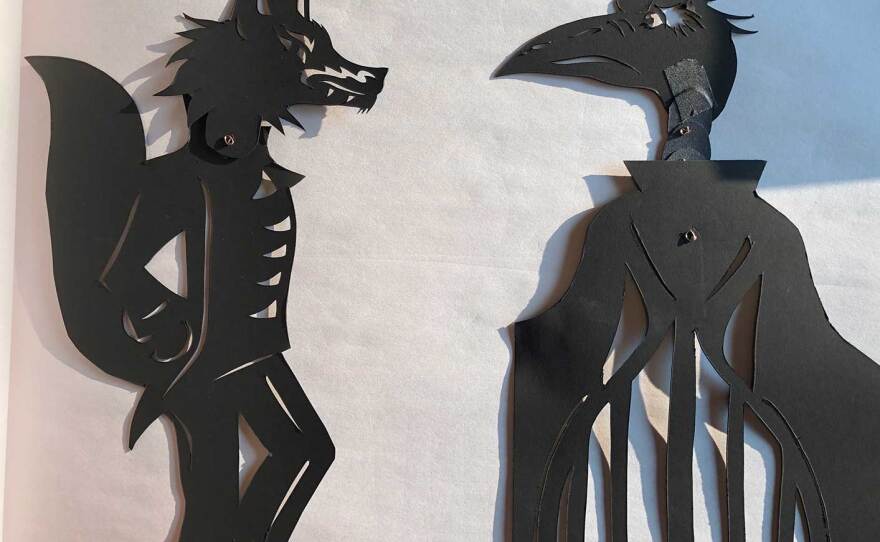"How can opera exist when we can't sing in each other's faces, when it's just not safe to do it yet?" mused mezzo-soprano Leslie Ann Leytham. Leytham is part of local cross-disciplinary arts group Project [BLANK]. Their short opera video, "Hanjo," just won the nationwide Catapult Opera Accelerate Competition's innovation prize.
"I really, really loved the challenge, I kind of loved the creation when given limitations," Leytham said.
Shot on an iPhone, the fast-tracked, socially distant work is a single scene from Toshio Hosokawa's 2004 opera "Hanjo," is a study in refined reduction in performance work.
The piece features black and white papercut puppetry, two voices and an original arrangement of the orchestral work for just piano — though through modifications to the piano and pianist Brendan Nguyen's technique, it eerily evokes the sonic qualities of other instruments.
Running just seven and a half minutes, the segment lands the viewers pretty far along in the plot. A young geisha, Hanoko, falls in love with a man, Yoshio, who promises to return to find her. When he doesn't, the young woman is taken in by Jitsuko, an artist and older woman, who takes her to Tokyo to keep her as a possession.

Of course, Yoshio finds her, and this is where Project [BLANK]’s excerpt comes in. The two voices are Jitsuko, interpreted as a crane (sung by Leytham) and Yoshio, interpreted as a fox (performed by baritone Jonathan Nussman).
Tania Yager, who created the original shadow puppetry, said she was inspired by traditional Japanese aesthetics and the stories of Japanese "yōkai," which are supernatural spirits that transcend human or animal forms.
Yager's silhouette-based puppets and sets play up the negative space and the starkness of shadows. Another limitation the team embraced was the lack of dynamic facial expression or minute speaking movements from the puppets. In this way, it depends on both the beholder and the music to fill in the blanks. Similarly, the role of the puppeteer is transparent.
"We did try to hide rods when we could hide rods, and did not worry about showing rods when we couldn't," Yager said. She said that it challenges animation or cartoon-dependent audiences. "They're too used to being spoon fed — as far as I'm concerned — their imagination," said Yager.

And dropping the audience in at this climactic moment in the story, without the background, builds on the thematic simplicity as the viewer fills in their own story.
"There's this whole backstory. The context makes so much more sense and without it we were struggling to try to find ways to contextualize this conversation," Leytham said. But to the team, the struggle was welcome. "It was fun in a way, to play. And to rethink the playground," Leytham added.
Joe Cantrell, who mixed and engineered the audio, as well as edited the video, said that on a technical and production level, he also approached this in a way outside of the standard forms.
Opera singers — like Nussman and Leytham — use the acoustics of the room for their instrument as much as they use their own bodies. So without the room and space involved, Cantrell said that he wanted to approach the sound more like pop music, designed to be listened to with earphones or on a smaller speaker.
"Normally, when classical music or western art music is produced and recorded, there's a huge emphasis on keeping dynamics. In other words, keeping the quiet things very quiet and the loud things very loud. But I went the other direction than that, specifically because of this idea of space and reimagining things," Cantrell said. "You can hear a lot of the nuances."

Also turning things on end is Nguyen's nearly unbelievable use of the piano. In a sort of sonic trickery, he is able to mimic the sound of instruments like strings, woodwinds and percussion, not just through performance technique but through modifying the physicality of the piano.
Nguyen embraced this undertaking because he's generally dissatisfied with piano arrangements of orchestral work. "I really felt like I needed to reverse engineer the orchestra in order to make the music work at all. Otherwise you just hear little twinkly piano sounds that seem to not have any presence in the music whatsoever," he said.
He coated fishing line with rosin and bowed strings inside of the piano to make a sound that mimicked the violin or cello. He used the piano's natural percussive state to create tam tam and bass drum sounds.
The horns and woodwinds were trickier. "Actually I almost pretty much gave up on the horn section," Nguyen joked. "For the brass section I was like, you know what, there should be some traditional piano sounds!". Woodwinds utilized some of the same stringing techniques as the violins, but he also brought in butcher's twine for different resonance and an e-bow — an electronic device that is generally used to hum a constant note against guitar strings.
Nguyen knew he couldn't exactly mimic an orchestra. "The goal really was to provide the wide color palette, the auditory interest that an orchestra inherently has," he said. His work makes the piano feel both more massive and more specific.
Ultimately, the piece was made in a way that would be difficult to perform live, said Nussman. It eschewed standard orchestra arrangements and "belle canto"-style traditional vocal performance — "We could explore ugly, and we could explore really intensely quiet," said Leytham. So much of the work's innovation dwells in the restrictions — whether they're from the pandemic, or self-imposed.
Project [BLANK]'s "Hanjo," which won the Catapult Opera Innovation Prize, is available to view online.

![Local arts group Project [BLANK]'s shadow puppet digital opera won a nationwide award in October 2020 — and the piece challenges how to record and engineer orchestral and opera works in digital platforms.](https://cdn.kpbs.org/dims4/default/eed41bc/2147483647/strip/true/crop/1371x844+0+111/resize/880x542!/quality/90/?url=http%3A%2F%2Fkpbs-brightspot.s3.us-west-2.amazonaws.com%2Fimg%2Fphotos%2F2020%2F11%2F05%2FHANAKO-CAGE-crop-twisted-heart.jpg)




